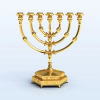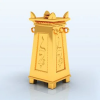phipps
Star
- Joined
- Dec 27, 2017
- Messages
- 4,809
Summary: God's people in the Old Testament were told to build a sanctuary, modelled after the true sanctuary, which is in heaven.
"And let them make me a sanctuary; that I may dwell among them. According to all that I shew thee, after the pattern of the tabernacle, and the pattern of all the instruments thereof, even so shall ye make it" (Exodus 25:8-9).
When God instructed Moses to build the earthly sanctuary, He told him to make it according to “the pattern of the tabernacle.” God Himself gave this pattern to Moses. It was not a pattern after anything that had ever been made on Earth. This was a pattern of something only heavenly eyes had ever beheld. It was a pattern of the sanctuary in heaven.
The book of Hebrews gives us a lot of information about this heavenly sanctuary and its High Priest:
"Seeing then that we have a great high priest, that is passed into the heavens, Jesus the Son of God, let us hold fast our profession. For we have not an high priest which cannot be touched with the feeling of our infirmities; but was in all points tempted like as we are, yet without sin. Let us therefore come boldly unto the throne of grace, that we may obtain mercy, and find grace to help in time of need" (Hebrews 4:14-16).
"Now of the things which we have spoken this is the sum: We have such an high priest, who is set on the right hand of the throne of the Majesty in the heavens; A minister of the sanctuary, and of the true tabernacle, which the Lord pitched, and not man…Who serve unto the example and shadow of heavenly things, as Moses was admonished of God when he was about to make the tabernacle: for, See, saith he, that thou make all things according to the pattern shewed to thee in the mount" (Hebrews 8:1-2, 5).
"But Christ being come an high priest of good things to come, by a greater and more perfect tabernacle, not made with hands, that is to say, not of this building; Neither by the blood of goats and calves, but by his own blood he entered in once into the holy place, having obtained eternal redemption for us" (Hebrews 9:11-12).
"Therefore it was necessary that the copies of the things in the heavens should be purified with these, but the heavenly things themselves with better sacrifices than these. For Christ has not entered the holy places made with hands, which are copies of the true, but into heaven itself, now to appear in the presence of God for us; not that He should offer Himself often, as the high priest enters the Most Holy Place every year with blood of another—He then would have had to suffer often since the foundation of the world; but now, once at the end of the ages, He has appeared to put away sin by the sacrifice of Himself. And as it is appointed for men to die once, but after this the judgment, so Christ was offered once to bear the sins of many. To those who eagerly wait for Him He will appear a second time, apart from sin, for salvation" (Hebrews 9:23-28).
God’s people needed the earthly sanctuary to help them understand the heavenly sanctuary and the plan of salvation. When the lamb was put on the altar it was to signify Jesus’ great sacrifice for our sins as the only way to find pardon and enter into eternal life.
The earthly sanctuary also represented Christ’s mediatory role. As the people went to the priest and watched him perform the duty of mediation in the holy and most holy place, they were to understand that we cannot approach God without Christ interceding on our behalf. So Jesus not only fulfils the role of the lamb that was sacrificed, but also the priest who steps between God and us and shows that our sins have been covered by His blood. We have been made worthy of salvation because we are covered in His righteousness, not our own.
The Bible tells us that all of this is going on right now in the heavenly sanctuary. This time it is Jesus Himself entering in with His very own precious blood to cover every sin that has been sincerely confessed. That is what Paul is talking about in Hebrews 12:24 when he says, “And to Jesus the mediator of the new covenant, and to the blood of sprinkling, that speaketh better things than that of Abel.” He also tells us, “For there is one God, and one mediator between God and men, the man Christ Jesus” (1 Timothy 2:5).
Even the book of Revelation speaks about the tabernacle in heaven:
"And the temple of God was opened in heaven, and there was seen in his temple the ark of his testament: and there were lightnings, and voices, and thunderings, and an earthquake, and great hail" (Revelation 11:19).
"And he opened his mouth in blasphemy against God, to blaspheme his name, and his tabernacle, and them that dwell in heaven" (Revelation 13:6).
"And after that I looked, and, behold, the temple of the tabernacle of the testimony in heaven was opened" (Revelation 15:5).
What a loving God we serve! He demonstrates so fully His great sacrifice for us by giving us a real life demonstration of what is taking place in heaven. We are living in a most amazing time in history as Jesus Himself bridges the gap between Earth and heaven and will one day come as King to take us home.
"For he hath looked down from the height of his sanctuary; from heaven did the LORD behold the earth" (Psalm 102:19).
"And let them make me a sanctuary; that I may dwell among them. According to all that I shew thee, after the pattern of the tabernacle, and the pattern of all the instruments thereof, even so shall ye make it" (Exodus 25:8-9).
When God instructed Moses to build the earthly sanctuary, He told him to make it according to “the pattern of the tabernacle.” God Himself gave this pattern to Moses. It was not a pattern after anything that had ever been made on Earth. This was a pattern of something only heavenly eyes had ever beheld. It was a pattern of the sanctuary in heaven.
The book of Hebrews gives us a lot of information about this heavenly sanctuary and its High Priest:
"Seeing then that we have a great high priest, that is passed into the heavens, Jesus the Son of God, let us hold fast our profession. For we have not an high priest which cannot be touched with the feeling of our infirmities; but was in all points tempted like as we are, yet without sin. Let us therefore come boldly unto the throne of grace, that we may obtain mercy, and find grace to help in time of need" (Hebrews 4:14-16).
"Now of the things which we have spoken this is the sum: We have such an high priest, who is set on the right hand of the throne of the Majesty in the heavens; A minister of the sanctuary, and of the true tabernacle, which the Lord pitched, and not man…Who serve unto the example and shadow of heavenly things, as Moses was admonished of God when he was about to make the tabernacle: for, See, saith he, that thou make all things according to the pattern shewed to thee in the mount" (Hebrews 8:1-2, 5).
"But Christ being come an high priest of good things to come, by a greater and more perfect tabernacle, not made with hands, that is to say, not of this building; Neither by the blood of goats and calves, but by his own blood he entered in once into the holy place, having obtained eternal redemption for us" (Hebrews 9:11-12).
"Therefore it was necessary that the copies of the things in the heavens should be purified with these, but the heavenly things themselves with better sacrifices than these. For Christ has not entered the holy places made with hands, which are copies of the true, but into heaven itself, now to appear in the presence of God for us; not that He should offer Himself often, as the high priest enters the Most Holy Place every year with blood of another—He then would have had to suffer often since the foundation of the world; but now, once at the end of the ages, He has appeared to put away sin by the sacrifice of Himself. And as it is appointed for men to die once, but after this the judgment, so Christ was offered once to bear the sins of many. To those who eagerly wait for Him He will appear a second time, apart from sin, for salvation" (Hebrews 9:23-28).
God’s people needed the earthly sanctuary to help them understand the heavenly sanctuary and the plan of salvation. When the lamb was put on the altar it was to signify Jesus’ great sacrifice for our sins as the only way to find pardon and enter into eternal life.
The earthly sanctuary also represented Christ’s mediatory role. As the people went to the priest and watched him perform the duty of mediation in the holy and most holy place, they were to understand that we cannot approach God without Christ interceding on our behalf. So Jesus not only fulfils the role of the lamb that was sacrificed, but also the priest who steps between God and us and shows that our sins have been covered by His blood. We have been made worthy of salvation because we are covered in His righteousness, not our own.
The Bible tells us that all of this is going on right now in the heavenly sanctuary. This time it is Jesus Himself entering in with His very own precious blood to cover every sin that has been sincerely confessed. That is what Paul is talking about in Hebrews 12:24 when he says, “And to Jesus the mediator of the new covenant, and to the blood of sprinkling, that speaketh better things than that of Abel.” He also tells us, “For there is one God, and one mediator between God and men, the man Christ Jesus” (1 Timothy 2:5).
Even the book of Revelation speaks about the tabernacle in heaven:
"And the temple of God was opened in heaven, and there was seen in his temple the ark of his testament: and there were lightnings, and voices, and thunderings, and an earthquake, and great hail" (Revelation 11:19).
"And he opened his mouth in blasphemy against God, to blaspheme his name, and his tabernacle, and them that dwell in heaven" (Revelation 13:6).
"And after that I looked, and, behold, the temple of the tabernacle of the testimony in heaven was opened" (Revelation 15:5).
What a loving God we serve! He demonstrates so fully His great sacrifice for us by giving us a real life demonstration of what is taking place in heaven. We are living in a most amazing time in history as Jesus Himself bridges the gap between Earth and heaven and will one day come as King to take us home.
"For he hath looked down from the height of his sanctuary; from heaven did the LORD behold the earth" (Psalm 102:19).
Last edited:












